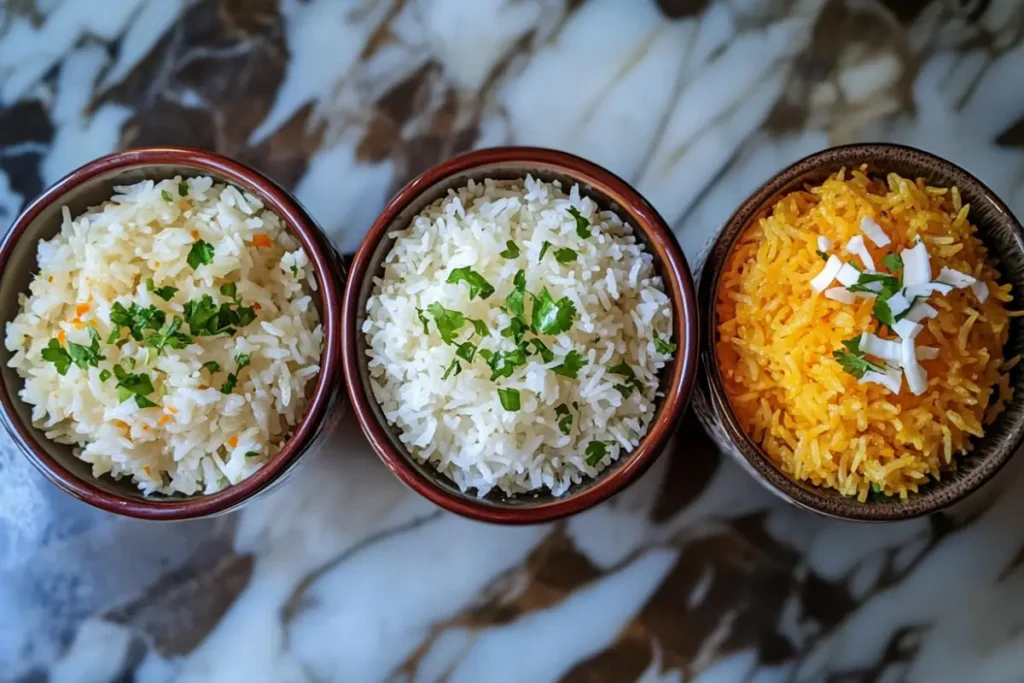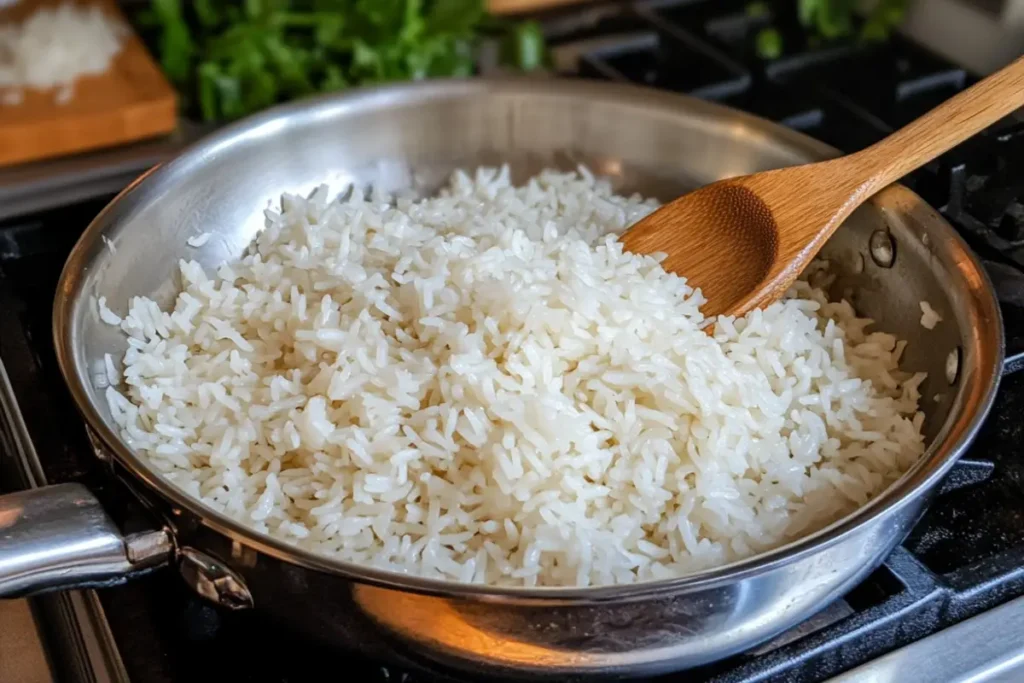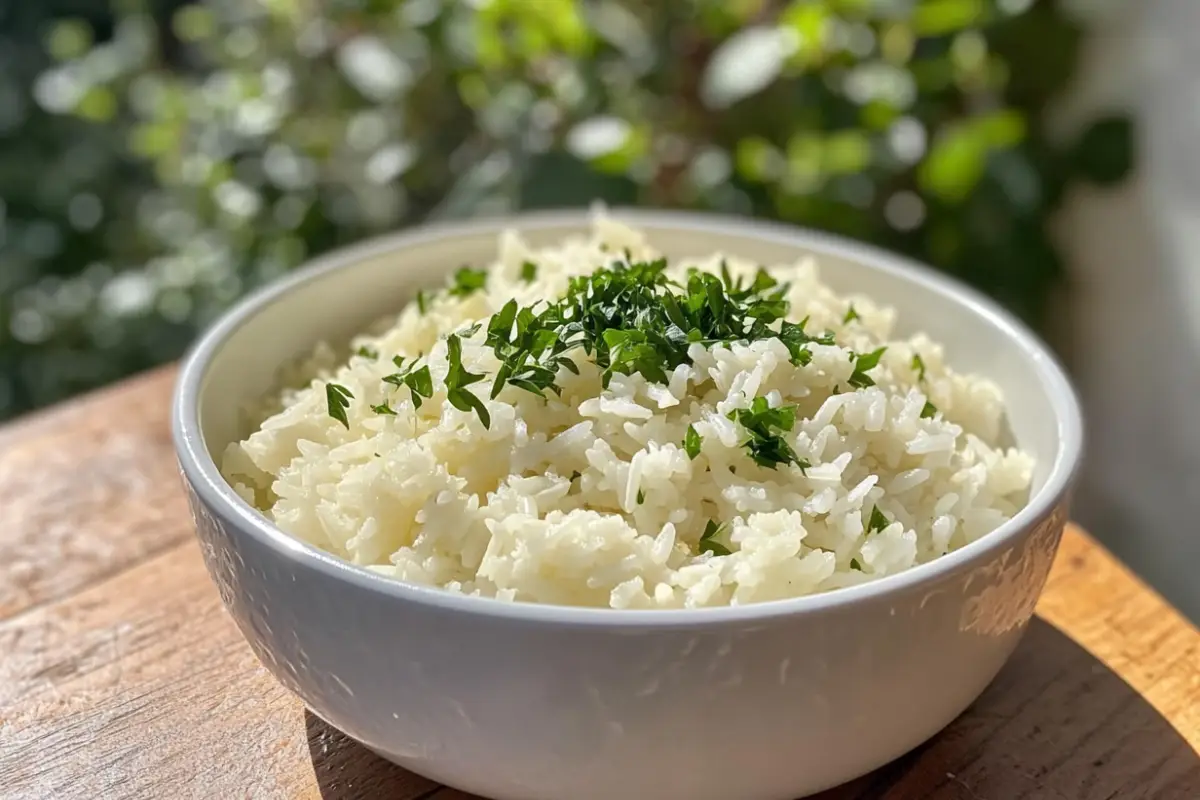Last Updated on January 20, 2025 by Souhail
Have you ever wondered why restaurant rice always seems so perfect—fluffy, flavorful, and just the right texture? Replicating that magic at home can feel like a culinary mystery, but it doesn’t have to be. With a few clever tricks and tweaks, you can make your rice taste like restaurant quality, elevating even the simplest meal into something special.
In this guide, we’ll uncover the secrets behind why restaurant rice is so delicious and how you can achieve that same result. From choosing the right rice to mastering cooking techniques, this article is packed with tips to help you serve up rice that’s fluffy, aromatic, and bursting with flavor.
Table of contents
- Why Does Restaurant Rice Taste Better?
- How to Add Flavor to Rice Like a Pro
- Variants to Make Rice Taste Like Restaurant Specialties
- Common Mistakes That Ruin Rice
- Pro Tips for Restaurant-Style Rice
- How to Store and Reheat Rice Like a Pro
- Essential Tools for Perfect Rice Every Time
- Restaurant-Style Rice on a Budget
- The Role of Aromatics in Enhancing Rice Flavor
- Final Thoughts
Why Does Restaurant Rice Taste Better?
Making rice taste like restaurant quality starts with understanding the techniques chefs use to bring out the best in this humble grain. Here’s what makes it stand out:
1. The Right Rice Variety
Restaurants choose rice varieties that complement their cuisine. For example, long-grain basmati is ideal for Indian dishes, while short-grain sushi rice is essential for Japanese meals. These types of rice have distinctive textures and aromas that elevate the final dish.
- Pro Tip: If you want your rice to taste like restaurant quality, invest in high-quality brands. Look for aromatic options like jasmine or basmati for everyday meals.
2. Rinsing for Perfection
Washing rice removes excess starch that can make it gummy or sticky. Restaurants often rinse their rice several times until the water runs clear.
- Pro Tip: Place your rice in a fine-mesh strainer or bowl, cover it with water, and gently swish. Repeat until the water is no longer cloudy.
3. Using the Right Liquid
One of the biggest secrets to making rice taste like restaurant quality is replacing plain water with broth or stock. This simple swap infuses every grain with savory flavor.
- Pro Tip: Use chicken, beef, or vegetable broth instead of water. Add aromatics like a bay leaf or a cinnamon stick for even more depth.
4. Precise Cooking Ratios
Restaurants measure rice and water with precision to avoid undercooked or mushy results. The right ratio depends on the type of rice.
- Pro Tip: For most long-grain rice, use a 1:2 ratio (one part rice to two parts water). Adjust slightly for short-grain varieties.
5. Steaming for Fluffiness
Chefs know the importance of resting rice after cooking. Letting it steam ensures light, fluffy grains instead of clumps.
- Pro Tip: After turning off the heat, leave the pot covered for 10 minutes before fluffing with a fork.
How to Add Flavor to Rice Like a Pro

If you’re aiming to make your rice taste like restaurant dishes, flavor is key. Here are a few simple ways to upgrade your rice game:
1. Toast the Rice
Before adding liquid, toast your rice in a bit of butter or oil. This enhances its nutty flavor and adds depth to the dish.
2. Season the Water
Just like with pasta, salting the water makes a huge difference. Don’t skip this step if you want your rice to taste like restaurant-quality food.
3. Aromatic Additions
Add whole spices like cardamom pods, cloves, or star anise while cooking. These subtle flavors will infuse the rice beautifully.
4. Finish with Fresh Herbs
Once cooked, toss your rice with chopped parsley, cilantro, or mint for a fresh, vibrant touch.
5. Experiment with Fats
A small amount of butter, olive oil, or coconut oil can make a world of difference. It adds richness and enhances the overall texture.
Variants to Make Rice Taste Like Restaurant Specialties

1. Saffron Rice
Infuse your rice with the luxurious aroma and color of saffron. Steep saffron threads in warm water and mix it with the rice before cooking.
2. Coconut Rice
Swap out water for coconut milk, and add a pinch of sugar and salt for a tropical twist that pairs beautifully with curries.
3. Mexican Rice
Cook your rice in a tomato-based broth with onions, garlic, and spices like cumin. This classic side dish complements tacos and enchiladas.
4. Garlic Herb Rice
Sauté minced garlic in butter before adding the rice and liquid. Finish with fresh parsley for a fragrant, restaurant-style side.
5. Pilaf-Style Rice
Transform your rice into a flavorful pilaf by cooking it with onions, spices, and broth. Add toasted nuts and dried fruit for an elegant presentation.
Common Mistakes That Ruin Rice
Making rice taste like restaurant quality is easier when you avoid these common pitfalls:
- Skipping the Wash: Unwashed rice often turns out sticky and clumpy.
- Using Too Much Water: Over-saturating rice can result in a mushy texture.
- Not Resting the Rice: Skipping the steaming step can lead to unevenly cooked grains.
- Over-Stirring: Stirring rice while it cooks can break grains and make them mushy.
Pro Tips for Restaurant-Style Rice
- Invest in a Rice Cooker
Restaurants often use specialized rice cookers for consistent results. At home, a good rice cooker can take the guesswork out of the process. - Fluff with a Fork
Never use a spoon to stir cooked rice. Instead, fluff gently with a fork to preserve its texture. - Double the Batch
Cooking extra rice ensures you always have day-old rice for fried rice, which is a classic restaurant trick. - Layer Flavors Post-Cooking
Zest lemon or lime over cooked rice for a citrusy lift, or drizzle it with a flavored oil like truffle or garlic-infused olive oil. - Keep It Simple
Sometimes, less is more. Focus on cooking your rice perfectly, then enhance it with just one or two accents.
How to Store and Reheat Rice Like a Pro
Storing and reheating rice the right way ensures it retains its restaurant-quality flavor and texture. Improper storage can lead to dry or mushy rice and even safety concerns. Follow these tips to keep your rice fresh and delicious:
Storing Cooked Rice
- Cool It Quickly: After cooking, let the rice cool to room temperature within one hour to prevent bacterial growth.
- Use Airtight Containers: Transfer the cooled rice into an airtight container to lock in moisture and prevent drying out.
- Refrigerate Promptly: Store rice in the refrigerator within two hours of cooking. Properly stored rice can last 3–5 days.
- Freeze for Long-Term Storage: For extended shelf life, freeze rice in individual portions. Use freezer-safe bags and press out the air before sealing.
Reheating Cooked Rice
- Microwave Method: Add a splash of water to the rice, cover it with a damp paper towel, and microwave in 30-second intervals, fluffing in between.
- Stovetop Method: Heat rice in a pan with a small amount of water or broth. Stir occasionally to prevent sticking.
- Steamer Method: Place the rice in a heatproof dish and steam for 5–10 minutes until it’s fluffy and warm.
Essential Tools for Perfect Rice Every Time
Making rice taste like restaurant dishes is much easier with the right tools. These kitchen essentials ensure consistently perfect results:
- Rice Cooker
A rice cooker is the ultimate convenience tool, delivering perfectly cooked rice with minimal effort. Look for models with settings for different rice types. - Heavy-Bottomed Pot
If you prefer stovetop cooking, a heavy-bottomed pot with a tight-fitting lid is essential. It prevents uneven cooking and ensures no burning. - Fine-Mesh Strainer
A fine-mesh strainer makes rinsing rice quick and efficient, removing excess starch for fluffier grains. - Wooden Spoon or Fork
Use a wooden spoon or fork to fluff rice gently. This preserves the texture and prevents clumping. - Steamer Basket
For sticky rice or reheating, a steamer basket ensures even heat distribution without drying out the grains.
Restaurant-Style Rice on a Budget
You don’t need expensive ingredients or fancy equipment to make your rice taste like restaurant-quality dishes. With a few cost-effective strategies, you can achieve exceptional results without breaking the bank.
1. Choose Budget-Friendly Rice Varieties
While specialty rice like basmati or jasmine can be pricey, there are affordable options that still deliver great results. Look for store-brand long-grain rice, parboiled rice, or bulk-buy options at warehouse clubs.
- Pro Tip: Bulk stores often sell quality rice at a fraction of the price per pound compared to pre-packaged bags.
2. Enhance with Everyday Ingredients
You don’t need special spices to elevate your rice. Simple pantry staples like garlic, onions, and bouillon cubes can add layers of flavor.
- Example: Dissolve a bouillon cube in the cooking water for a quick and affordable flavor boost.
3. Reuse Aromatics
If you’ve used herbs like parsley, thyme, or cilantro in another recipe, save the stems for rice. Adding these to the cooking liquid infuses subtle flavors without additional cost.
4. Utilize Leftovers
Transform leftover rice into fried rice or pilaf, minimizing waste while creating a restaurant-style meal.
- Pro Tip: Day-old rice works best for fried rice because it’s less sticky and absorbs sauces better.
5. DIY Spice Mixes
Instead of buying expensive pre-made spice blends, create your own using spices you already have. For example, mix cumin, paprika, and garlic powder for a Mexican-inspired rice seasoning.
6. Invest in a Multi-Purpose Tool
While high-end rice cookers can be pricey, there are affordable models that deliver excellent results. Additionally, a sturdy pot with a lid is a cost-effective alternative for perfectly cooked rice.
7. Cook in Bulk
Cooking rice in large batches saves time, energy, and money. Store portions in the fridge or freezer for future meals, ensuring you always have restaurant-style rice ready to go.
By focusing on these budget-friendly strategies, you can consistently prepare rice that tastes like it came from your favorite restaurant—without overspending.
The Role of Aromatics in Enhancing Rice Flavor

Aromatics are one of the most important elements in making rice taste like restaurant-quality dishes. These ingredients infuse the rice with subtle layers of flavor that elevate its overall taste.
Common Aromatics for Rice
- Onions and Garlic: Sautéing onions and garlic before adding rice creates a savory base.
- Whole Spices: Add bay leaves, cinnamon sticks, cardamom pods, or cloves to the cooking liquid for subtle warmth and complexity.
- Herbs: Fresh herbs like thyme, parsley, or cilantro can be added during or after cooking to brighten the dish.
- Citrus Zest: Lemon or lime zest added to rice before serving adds a refreshing, tangy note.
- Ginger: A small piece of fresh ginger cooked with rice complements Asian or Indian flavors beautifully.
How to Use Aromatics in Rice
- Infusion: Add aromatics directly to the cooking liquid to let their flavors seep into the rice as it cooks.
- Layering: Sauté aromatics in oil or butter before adding rice to coat each grain in flavor.
- Garnishing: Use fresh herbs or citrus zest as a finishing touch to enhance the aroma and visual appeal.
By incorporating these aromatic elements, you can transform even the simplest rice into a flavor-packed side dish that tastes like it came from a restaurant kitchen.
Final Thoughts
Creating rice that tastes like it came straight from a restaurant isn’t as elusive as it seems. By using the right techniques, choosing high-quality ingredients, and incorporating simple flavor-enhancing tricks, you can elevate your rice dishes to the next level. Whether it’s a simple bowl of fluffy jasmine rice or a more elaborate saffron-infused creation, these tips will ensure every grain is perfectly cooked and bursting with flavor.
But why stop here? If you’re looking for a recipe to try out these tips and add an irresistible twist to your meals, don’t miss our recipe article: Elevate Your Meals with this Easy and Irresistible Sassy Rice Recipe. This vibrant and flavorful dish is sure to become a staple on your table.
Start experimenting in your kitchen today, and soon your rice will be the star of every meal. Share your creations, let us know your favorite tips, and don’t forget to explore more of our articles for delicious ideas that will transform your everyday cooking. Happy cooking!

